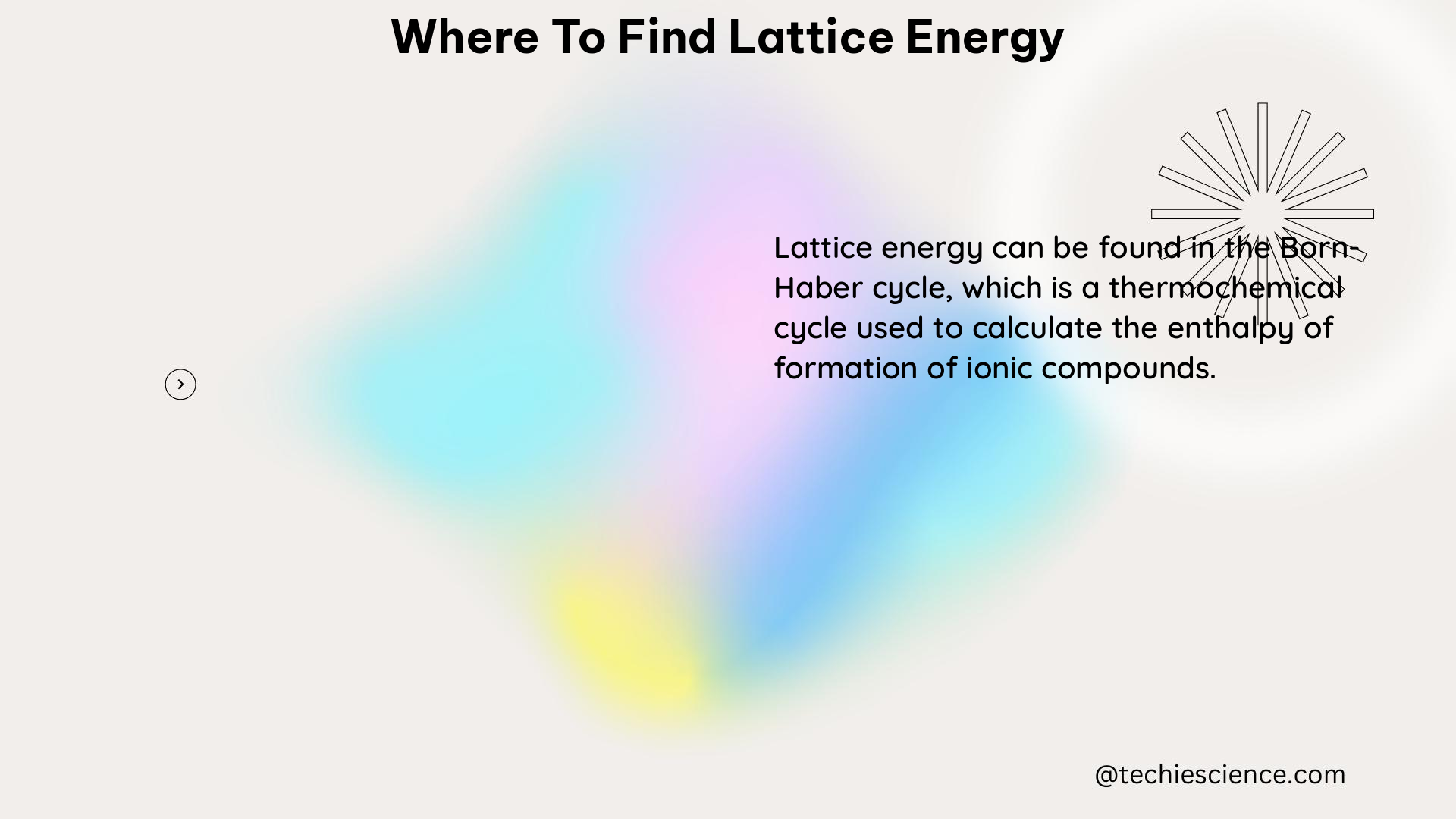Lattice energy is a fundamental concept in physical chemistry, particularly in the study of ionic compounds. It represents the energy required to separate the ions in a crystal lattice into individual gaseous ions, and it is a direct measure of the strength of the electrostatic interactions between the ions in the lattice. Understanding where to find lattice energy is crucial for determining the stability and reactivity of ionic compounds.
The Born-Haber Cycle: A Powerful Tool for Calculating Lattice Energy
The Born-Haber cycle is a widely used method for calculating lattice energy. This thermochemical cycle breaks down the formation of an ionic solid into a series of individual steps, including the enthalpy of sublimation, ionization energy, electron affinity, and lattice energy itself. The Born-Haber cycle is based on Hess’s law, which states that the total enthalpy change for a reaction is the same whether it occurs in one step or in a series of steps.
The Born-Haber cycle can be represented by the following equation:
ΔHformation = ΔHatomization + D + (∑IE) + (∑EA) + Lattice energy
Where:
– ΔHformation is the heat of formation
– ΔHatomization is the heat of atomization
– D is the dissociation energy
– IE is the ionization energy
– EA is the electron affinity
– Lattice energy is the lattice energy of the ionic compound
By rearranging this equation, we can solve for the lattice energy:
Lattice energy = ΔHformation – ΔHatomization – D – (∑IE) – (∑EA)
This equation allows us to calculate the lattice energy of an ionic compound based on the known values of the other thermochemical parameters.
Factors Affecting Lattice Energy

The magnitude of the lattice energy depends on several factors, including the charges of the ions and the distance between them. The lattice energy can be calculated using the following equation:
Lattice energy = (k * (Q+) * (Q-)) / d
Where:
– k is the electrostatic constant
– Q+ is the charge on the cation
– Q- is the charge on the anion
– d is the distance between the ions in the lattice
From this equation, we can see that the lattice energy is directly proportional to the charges of the ions and inversely proportional to the distance between them. This means that ionic compounds with higher charges and smaller ionic radii will have higher lattice energies, indicating stronger electrostatic interactions between the ions.
Examples of Lattice Energy Calculations
Let’s consider two examples to illustrate the differences in lattice energy:
- Sodium Chloride (NaCl):
- Charge on Na+ cation: +1
- Charge on Cl- anion: -1
- Ionic radius of Na+: 0.95 Å
- Ionic radius of Cl-: 1.81 Å
-
Lattice energy of NaCl: approximately 787 kJ/mol
-
Magnesium Oxide (MgO):
- Charge on Mg2+ cation: +2
- Charge on O2- anion: -2
- Ionic radius of Mg2+: 0.72 Å
- Ionic radius of O2-: 1.26 Å
- Lattice energy of MgO: approximately 3900 kJ/mol
The difference in lattice energy between NaCl and MgO reflects the stronger electrostatic interactions between the magnesium and oxygen ions, which have higher charges and smaller ionic radii compared to the sodium and chloride ions.
Practical Applications of Lattice Energy
Lattice energy is an essential concept in understanding the stability and reactivity of ionic compounds. It plays a crucial role in various applications, such as:
-
Predicting the Feasibility of Ionic Compound Formation: The lattice energy can be used to predict whether the formation of an ionic compound is feasible or not. If the lattice energy is sufficiently high, the formation of the ionic compound is likely to be favorable.
-
Explaining the Solubility of Ionic Compounds: The lattice energy of an ionic compound is related to its solubility in water. Compounds with lower lattice energies are generally more soluble, as the energy required to separate the ions in the lattice is lower.
-
Understanding the Strength of Ionic Bonds: The magnitude of the lattice energy provides insight into the strength of the ionic bonds within the crystal lattice. Compounds with higher lattice energies have stronger ionic bonds, which can affect their physical and chemical properties.
-
Analyzing the Energetics of Chemical Reactions: Lattice energy is an essential factor in the thermochemistry of ionic compounds, as it contributes to the overall enthalpy change of a reaction.
-
Designing and Optimizing Ionic Materials: Knowledge of lattice energy is crucial in the design and optimization of ionic materials, such as ceramics, glasses, and ionic conductors, which have a wide range of applications in various industries.
Conclusion
Lattice energy is a fundamental concept in physical chemistry that is crucial for understanding the stability and reactivity of ionic compounds. The Born-Haber cycle is a powerful tool for calculating lattice energy, and the magnitude of the lattice energy depends on the charges of the ions and the distance between them. Understanding where to find lattice energy and the factors that affect it is essential for physics students and researchers working with ionic materials.
References:
- Lattice Energy and Enthalpy of Solution | General Chemistry. Retrieved from https://courses.lumenlearning.com/suny-binghamton-chemistry/chapter/lattice-energy-and-enthalpy-of-solution/
- Lattice Energy: The Born-Haber cycle – Chemistry LibreTexts. Retrieved from https://chem.libretexts.org/Bookshelves/Inorganic_Chemistry/Supplemental_Modules_and_Websites_%28Inorganic_Chemistry%29/Crystal_Lattices/Thermodynamics_of_Lattices/Lattice_Energy:_The_Born-Haber_cycle
- Lattice Energy. Retrieved from https://chemed.chem.purdue.edu/genchem/topicreview/bp/ch7/lattice.html

The lambdageeks.com Core SME Team is a group of experienced subject matter experts from diverse scientific and technical fields including Physics, Chemistry, Technology,Electronics & Electrical Engineering, Automotive, Mechanical Engineering. Our team collaborates to create high-quality, well-researched articles on a wide range of science and technology topics for the lambdageeks.com website.
All Our Senior SME are having more than 7 Years of experience in the respective fields . They are either Working Industry Professionals or assocaited With different Universities. Refer Our Authors Page to get to know About our Core SMEs.